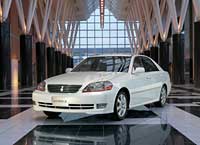|
|
|||||||
|
|
|||||||
|
|||||||
| | Web Japan >> | Trends in Japan >> | Business & Economy >> | In with the New | |
|
IN WITH THE NEW Carmakers Adapt Their Lineups to Changing Tastes (January 17, 2005) Mention the names Sunny, Mark II, or Familia to a Japanese car enthusiast of a certain age, and you'll likely trigger a nostalgic smile. For these are some of the long-running models that Japanese automakers first introduced in the 1950s and 1960s, just as the country was becoming a thoroughly motorized society. Now, however, these venerable marques have reached the end of the road, and carmakers are replacing them with new models better suited to the diverse desires of twenty-first century drivers. New Names Spawn New Images In recent years, however, sales of these and other long-standing models have plunged. Toyota introduced its Mark X in November 2004 to replace the Mark II, which had long served as its main sedan. The Mark II first came out in 1968, a time when Japan's economy was growing in leaps and bounds. It proved a goldmine for Toyota, selling in excess of 4.8 million vehicles. Yet by 2003, annual sales had dropped to around 40,000 vehicles, just a fifth of the figure achieved in 1990, when the model's popularity was at its peak. So the company finally decided to retire the venerable Mark II, which was then in its ninth incarnation. Toyota believes its successor, the Mark X, brings something brand new to its lineup. The new model is not only luxurious but also capable of high speeds, and, according to its maker, is exciting to drive. It has been a similar story with Nissan's Sunny (called the Nissan Sentra in some countries). It first rolled off the production line in 1966, becoming - along with Toyota's Corolla - a symbol of the era in which car ownership became the norm among ordinary Japanese families. The Sunny quickly established itself as Nissan's best-selling model, a kind of car for the masses. A total of 6.4 million Sunnys were sold during the model's lifetime. Recently, however, it had failed to attract many new customers, and sales had dropped off sharply. In 2003, just 42,000 Sunnys were sold, a mere seventh of the number sold during its peak sales year of 1973. The Sunny was finally retired in October 2004, to be succeeded by the new Tiida Latio. The Sunny was joined by two other 1960s marques, the Cedric and the Gloria sedans, both of which have been replaced by the Fuga. Nissan sees the new models as giving its lineup a fresh image for the new era. Mazda Motor Corp., meanwhile, retired its Familia (called the Mazda 323 overseas), formerly its main compact model, in October 2003. It has since been supplanted by the Axela (called the Mazda 3 overseas). Low-Volume Production to Satisfy Diverse Needs The car market is currently experiencing a period of rapid structural change. The popularity of sedans, for instance, is quickly waning. In 1986, they made up 34% of the domestic auto market, but by 2003 this figure had shrunk to just 12%. Minivans, meanwhile, which were only 3% of the market in 1986, now account for 16% of total auto sales in Japan. Automakers' marketing strategies had been stuck in a rut for some time. As car owners grew older, their perceptions of the cars they wanted to drive became more and more entrenched. Yet catering to this market by sticking to established models meant overlooking a younger and potentially lucrative segment of the market. Technology has helped to open up new possibilities. The use of increasingly advanced computers in development and production has shortened the time between the conception of a new model and the start of factory production, and different types of assembly can now be conducted on the same production line. In short, automakers are making the transition from low-mix, high volume production to high-mix, low-volume production, allowing them to quickly come out with a variety of different models aimed at specific areas of the market. In the future, the ability to exploit this advantage to cater to the diverse tastes of modern drivers will largely determine whether a car manufacturer survives or flounders. Copyright (c) 2005 Web Japan. Edited by Japan Echo Inc. based on domestic Japanese news sources. Articles presented here are offered for reference purposes and do not necessarily represent the policy or views of the Japanese Government. |
MOLDING THE FUTURE (November 28, 2003) TURNING POINT (August 7, 2003) |
|
|



